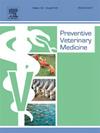Large heterogeneity in biosecurity legislation in the intensive pig production across Europe
IF 2.2
2区 农林科学
Q1 VETERINARY SCIENCES
引用次数: 0
Abstract
Implementing biosecurity measures in the pig production is crucial to optimize animal health and reduce antimicrobial usage. A legal framework may help to ensure all stakeholders understand the need of biosecurity measures and to implement them correctly. Limited knowledge is available about how implementation of biosecurity measures is regulated in European countries. Therefore, the aim of this study was to identify which biosecurity measures were mandatory by national legislation and/or by pig sector organizations of European countries for the intensive pig production under normal circumstances (i.e. no (threat of) disease outbreaks). A questionnaire including 51 biosecurity measures, 32 on external and 19 on internal, was developed and sent to national country representatives. Twenty-four European countries, of which 18 belonging to the European Union, indicated which biosecurity measures were mandatory by law. Four countries, France, Spain, Italy and Romania had a single national pig-specific biosecurity legislation, while in the other countries multiple legislations had to be consulted to complete the questionnaire. In general, there was a high heterogeneity in the number of measures that were mandatory by law per country. Most biosecurity measures addressed in the national legislation focused on external biosecurity and were measures that can be easily audited when conducting a farm visit such as the presence of a hygiene lock, fencing around the farm and the existence of documentation. A significant (p < 0.001) positive correlation was observed between the presence of external and internal biosecurity measures in the legislation. Yet, no significant association was observed between the number of biosecurity measures present in the national legislation and the size of the pig production. Fourteen countries indicated which biosecurity measures were required by pig sector organizations for intensive pig farms. The median number of biosecurity measures mandatory by pig sector organizations but not by law was 13 with a minimum of one measure in Germany and a maximum of 24 in Croatia. Different countries apply different strategies to increase the level of biosecurity. Further research is needed to investigate the impact of the different strategies on the implementation of biosecurity on intensive pig farms in the countries.
欧洲集约化养猪生产的生物安全立法存在很大差异
在生猪生产中实施生物安全措施对于优化动物健康和减少抗菌素的使用至关重要。法律框架可能有助于确保所有利益攸关方了解生物安全措施的必要性并正确实施这些措施。关于欧洲国家如何规范生物安全措施的实施,现有的知识有限。因此,本研究的目的是确定欧洲国家的国家立法和/或养猪部门组织在正常情况下(即没有疾病暴发(威胁))集约化养猪生产时必须采取哪些生物安全措施。编制了一份调查表,其中包括51项生物安全措施,其中32项为外部措施,19项为内部措施,并将其发送给国家代表。24个欧洲国家,其中18个属于欧盟,表明了哪些生物安全措施是法律强制性的。法国、西班牙、意大利和罗马尼亚这四个国家只有单一的国家特定猪种生物安全立法,而在其他国家,必须咨询多个立法才能完成调查问卷。一般来说,各国法律规定的强制性措施的数量差别很大。国家立法中涉及的大多数生物安全措施侧重于外部生物安全,这些措施在进行农场访问时可以很容易地进行审计,例如是否存在卫生锁、农场周围的围栏和是否存在文件。在立法中观察到外部和内部生物安全措施之间存在显著的正相关(p <; 0.001)。然而,没有观察到国家立法中存在的生物安全措施的数量与生猪生产规模之间的显著关联。14个国家指出了养猪部门组织对集约化养猪场需要采取哪些生物安全措施。由养猪部门组织强制实施而非法律规定的生物安全措施的中位数为13项,其中德国最低为1项,克罗地亚最高为24项。不同的国家采用不同的战略来提高生物安全水平。需要进一步的研究来调查不同策略对各国集约化养猪场实施生物安全的影响。
本文章由计算机程序翻译,如有差异,请以英文原文为准。
求助全文
约1分钟内获得全文
求助全文
来源期刊

Preventive veterinary medicine
农林科学-兽医学
CiteScore
5.60
自引率
7.70%
发文量
184
审稿时长
3 months
期刊介绍:
Preventive Veterinary Medicine is one of the leading international resources for scientific reports on animal health programs and preventive veterinary medicine. The journal follows the guidelines for standardizing and strengthening the reporting of biomedical research which are available from the CONSORT, MOOSE, PRISMA, REFLECT, STARD, and STROBE statements. The journal focuses on:
Epidemiology of health events relevant to domestic and wild animals;
Economic impacts of epidemic and endemic animal and zoonotic diseases;
Latest methods and approaches in veterinary epidemiology;
Disease and infection control or eradication measures;
The "One Health" concept and the relationships between veterinary medicine, human health, animal-production systems, and the environment;
Development of new techniques in surveillance systems and diagnosis;
Evaluation and control of diseases in animal populations.
 求助内容:
求助内容: 应助结果提醒方式:
应助结果提醒方式:


